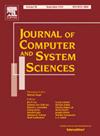正交压缩的参数化方法
IF 0.9
3区 计算机科学
Q1 BUSINESS, FINANCE
引用次数: 0
摘要
正交图用于UML图、VLSI布局、电缆计划和地铁地图等应用程序。我们专注于绘制平面图形,并假设我们得到了描述所需形状的正交表示,但不是绘图的确切坐标。我们的目标是在网格上计算一个正交图,该图在所有坚持给定正交表示的网格图中具有最小的面积。这个问题被称为正交压缩(OC),即使对于循环的正交表示也是np困难的[Evans等人,2022]。我们研究了OC相对于几个参数的复杂性。其中,我们证明了OC对于这些最自然的参数,即正交表示的kitty角的数量是固定参数可处理的:正交表示中kitty角对的存在使OC问题变得困难。非正式地说,一对猫咪角是一对互相指向对方的面部反射角。因此,猫咪角的数量是一些猫咪角对所涉及的角的数量。本文章由计算机程序翻译,如有差异,请以英文原文为准。
Parameterized approaches to orthogonal compaction
Orthogonal graph drawings are used in applications such as UML diagrams, VLSI layout, cable plans, and metro maps. We focus on drawing planar graphs and assume that we are given an orthogonal representation that describes the desired shape, but not the exact coordinates of a drawing. Our aim is to compute an orthogonal drawing on the grid that has the minimum area among all grid drawings that adhere to the given orthogonal representation. This problem is called orthogonal compaction (OC) and is known to be NP-hard, even for orthogonal representations of cycles [Evans et al. 2022]. We investigate the complexity of OC with respect to several parameters. Among others, we show that OC is fixed-parameter tractable with respect to the most natural of these parameters, namely, the number of kitty corners of the orthogonal representation: the presence of pairs of kitty corners in an orthogonal representation makes the OC problem hard. Informally speaking, a pair of kitty corners is a pair of reflex corners of a face that point at each other. Accordingly, the number of kitty corners is the number of corners that are involved in some pair of kitty corners.
求助全文
通过发布文献求助,成功后即可免费获取论文全文。
去求助
来源期刊

Journal of Computer and System Sciences
工程技术-计算机:理论方法
CiteScore
3.70
自引率
0.00%
发文量
58
审稿时长
68 days
期刊介绍:
The Journal of Computer and System Sciences publishes original research papers in computer science and related subjects in system science, with attention to the relevant mathematical theory. Applications-oriented papers may also be accepted and they are expected to contain deep analytic evaluation of the proposed solutions.
Research areas include traditional subjects such as:
• Theory of algorithms and computability
• Formal languages
• Automata theory
Contemporary subjects such as:
• Complexity theory
• Algorithmic Complexity
• Parallel & distributed computing
• Computer networks
• Neural networks
• Computational learning theory
• Database theory & practice
• Computer modeling of complex systems
• Security and Privacy.
 求助内容:
求助内容: 应助结果提醒方式:
应助结果提醒方式:


